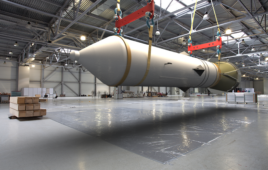 Servo systems more often than not require that mechanical components have a high torsional stiffness in order to perform properly in applications requiring rapid acceleration and deceleration of high inertia loads. Flexible couplings usually have the lowest torsional stiffness of any component in a motion system. All too often couplings are selected based on factors other than torsional stiffness, and frequently to the detriment of system performance. Proper servo coupling selection can pay off when considering the bigger picture.
Servo systems more often than not require that mechanical components have a high torsional stiffness in order to perform properly in applications requiring rapid acceleration and deceleration of high inertia loads. Flexible couplings usually have the lowest torsional stiffness of any component in a motion system. All too often couplings are selected based on factors other than torsional stiffness, and frequently to the detriment of system performance. Proper servo coupling selection can pay off when considering the bigger picture.
Engineers go to great lengths to ensure that inertia mismatch between the load and the servo motor is compensated for. Motors and gearheads are selected in such a way as to ensure the ability of the drive to accelerate the load with ease. The mechanical connection between the drive and the load however unvaryingly compromises the efforts of the drive system. The most compliant component in the mechanical system (e.g. the coupling) will be twisted back and forth by the settling motion of the load at any major velocity change. The formula for calculating torsional deflection based on load and stiffness is as follows:


Depending on the inertia of the load and its effect on peak torque this can happen to varying degrees. In any case however, more power is required in order to accelerate the load at the desired rate when a less rigid component is installed between the drive and the load. This may or may not pose a concern depending on the application, and tends to matter more in cases with a high inertia load which must be rapidly indexed. But another stiffness related factor must be considered.
When tuning servo drives, velocity and position feedback loops must be set to a low enough frequency so as not to excite the most torsionally compliant component in the system by reaching its natural frequency. Higher coupling stiffness leads to a higher natural frequency of the entire system, which means that feedback loops can be set to a higher frequency. This in turn leads to a faster moving and more accurate machine, and ultimately higher throughput and higher quality.
A commonly used calculation for determining required coupling stiffness, and / or maximum drive frequency utilizes what is called the “two-mass system.” In practice, if the calculation is carried out based on coupling stiffness alone, the calculated resonant frequency of the load has to be at least twice as high as the excitation frequency of the drive. 

Bellows couplings quite simply posses the highest torsional stiffness of commercially available flexible couplings, including disc and beam type couplings. Hydroformed from a continuous tube of stainless steel, bellows can easily flex laterally, angularly and axially with only very gentle restoring forces, but are highly rigid in rotation. This paired with a low moment of inertia makes bellows couplings appropriate for almost any application requiring optimum efficiency and performance in acceleration and positioning.
The exception lies in cases where neither a high level of dynamic positioning accuracy, nor the ability to optimize servo loop gains is critical. A vibration damping servo insert coupling can be a very dependable and low cost alternative in these cases. When pushing the limits of efficiency, accuracy and speed however, take the most torsionally rigid coupling possible for the best servo system you can design.
For more information on servo couplings, contact R+W America at (888) 479-8728 or visit at www.rw-america.com
:: Design World ::
Filed Under: Aerospace + defense, Couplings, Machine tools + subtractive manufacturing, Automotive, Semiconductor manufacture, Medical-device manufacture, FASTENING • JOINING • locks • latches • pins, Packaging, MECHANICAL POWER TRANSMISSION, Motion control • motor controls





Tell Us What You Think!